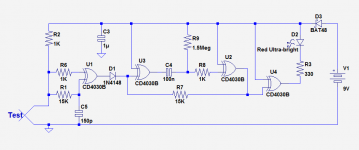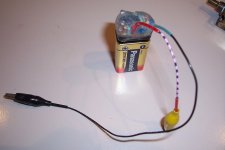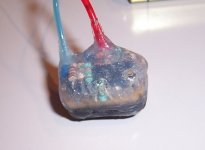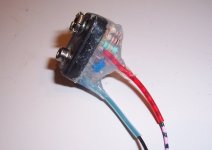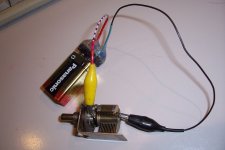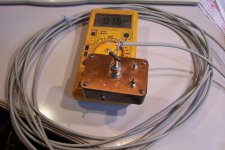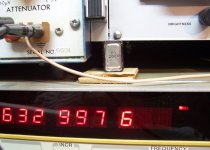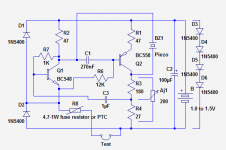Intermittents, bad contacts and similar woes are probably among the most exasperating one can be confronted to: they tend to keep quiet until you really need a particular piece of equipment to function spotlessly, and when you attempt to track them, either they disappear or give the impression of being eradicated... except they weren't.
This crude tool is very effective at detecting any kind of intermittent, be it a bad contact or a fugitive short: it will detect an event as short as a few tens of ns.

It is simply a positive and negative edge triggered one-shot: as soon as a transition is detected, an ultra-bright LED gives a flash of ~150ms.
You begin by connecting the tester to the whole contact loop, then you shake, twist, wiggle every part separately, noticing where the flashes are the most numerous.
You then narrow down the test to that particular section, and so on, until you have pinpointed the exact cause of the problem.
Once you think you have fixed the problem, you do once again a test of the full loop, to make sure you didn't miss anything.
The tester will detect intermittent opens and shorts. In practice, opens constitute more than 80% of the actual problems, but shorts do exist too: stray strands of multistrand wires touching something else, loose metallic chips of metal inside a connector, like chromium plating chipping off, or dendrites from certain alloys, etc.
The tester will catch them all: it will test switches, cables, interconnects, plug/jack combinations, sliding or rotary contacts, variable capacitors, break before make action of a selectors, etc, etc.
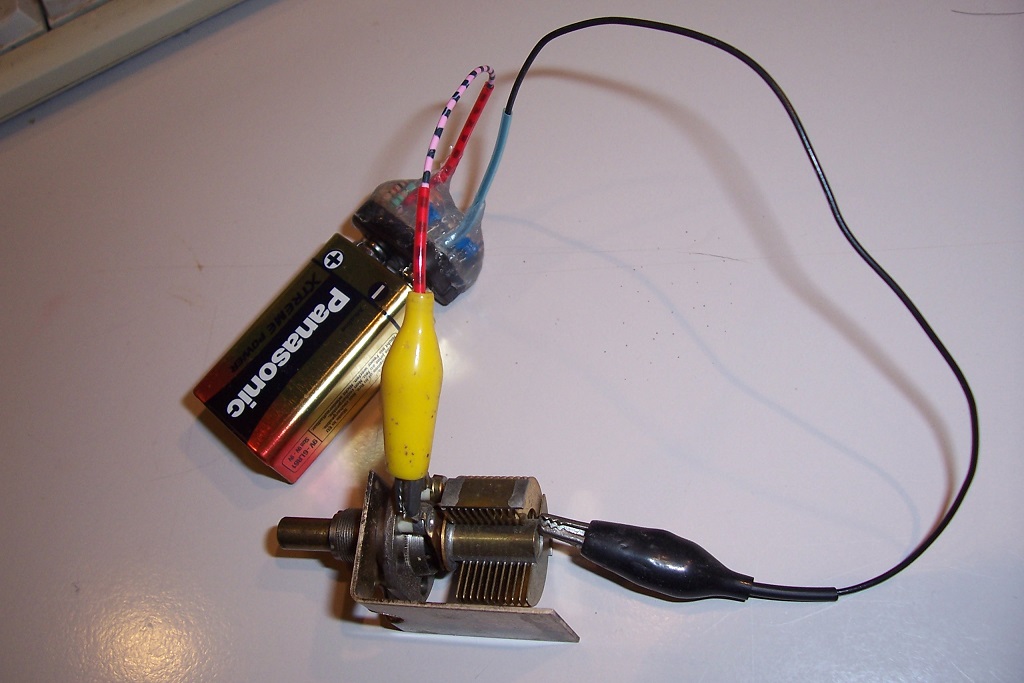
It is also dirt-cheap, compact (I built mine into the top cover of a 9V battery and I didn't use SMD components), robust and reliable.

I have coated mine with RTV silicone (non-acetic obviously) to protect it from shocks, vibration, accidental electrical contacts, humidity, liquids or any other contamination.


It requires no power switch, consuming only tens of pA in the idle state, and it can content itself with batteries considered worn by other equipments: less than 5V is enough, and the battery will last forever.
This crude tool is very effective at detecting any kind of intermittent, be it a bad contact or a fugitive short: it will detect an event as short as a few tens of ns.
It is simply a positive and negative edge triggered one-shot: as soon as a transition is detected, an ultra-bright LED gives a flash of ~150ms.
You begin by connecting the tester to the whole contact loop, then you shake, twist, wiggle every part separately, noticing where the flashes are the most numerous.
You then narrow down the test to that particular section, and so on, until you have pinpointed the exact cause of the problem.
Once you think you have fixed the problem, you do once again a test of the full loop, to make sure you didn't miss anything.
The tester will detect intermittent opens and shorts. In practice, opens constitute more than 80% of the actual problems, but shorts do exist too: stray strands of multistrand wires touching something else, loose metallic chips of metal inside a connector, like chromium plating chipping off, or dendrites from certain alloys, etc.
The tester will catch them all: it will test switches, cables, interconnects, plug/jack combinations, sliding or rotary contacts, variable capacitors, break before make action of a selectors, etc, etc.
It is also dirt-cheap, compact (I built mine into the top cover of a 9V battery and I didn't use SMD components), robust and reliable.
I have coated mine with RTV silicone (non-acetic obviously) to protect it from shocks, vibration, accidental electrical contacts, humidity, liquids or any other contamination.
It requires no power switch, consuming only tens of pA in the idle state, and it can content itself with batteries considered worn by other equipments: less than 5V is enough, and the battery will last forever.
Attachments
I have recently built a Weiland connector box with 7 leds in series with each of the 3 or 4 power circuits, and each of the 1 or 3 earth conductors (stage lighting multicore and chain motor multicore cables up to 60m long)....a companion box is connected at far end of the extension cable linking circuits, individual led on indicates individual circuit continuity.
This setup works well enough for detecting momentary opens but not the permanent ones that can't be found by moving the cable, and I have three such cables on the bench this week.
An uber useful gadget would be a 'dumbed down' TDR tester with led indication of distance to open circuit fault.
Ideally the indication would be for less than/more than a set of selectable preset distances such as 5m, 10m, 20m, 40m to enable decision of cut point of cable and conversion to two cables whilst retaining longest length possible.
Dan.
This setup works well enough for detecting momentary opens but not the permanent ones that can't be found by moving the cable, and I have three such cables on the bench this week.
An uber useful gadget would be a 'dumbed down' TDR tester with led indication of distance to open circuit fault.
Ideally the indication would be for less than/more than a set of selectable preset distances such as 5m, 10m, 20m, 40m to enable decision of cut point of cable and conversion to two cables whilst retaining longest length possible.
Dan.
Well, that's a completely different function; probably something a bit like this, but unfortunately, this one does not use LEDs, it displays the distance to the open or short on the multimeter it is plugged into:An uber useful gadget would be a 'dumbed down' TDR tester with led indication of distance to open circuit fault.
Ideally the indication would be for less than/more than a set of selectable preset distances such as 5m, 10m, 20m, 40m to enable decision of cut point of cable and conversion to two cables whilst retaining longest length possible.
Dan.
Also of interest could be this tester:
Instruments from beyond: 1-The Stufinator
It detects small deviations from the characteristic impedance caused by local damages like crushing, twisting or stretching
Attachments
Elvee,
Do you have a part number for the x-OR that you used in your
project detector? Was that a PDIP or smaller part?
Nice discreet parts. Was that a solid type 9V battery
board? I assume you mounted on standard type perf
board fitted to mount in the battery board?
Cheers,
Do you have a part number for the x-OR that you used in your
project detector? Was that a PDIP or smaller part?
Nice discreet parts. Was that a solid type 9V battery
board? I assume you mounted on standard type perf
board fitted to mount in the battery board?
Cheers,
It is a CD4030B, as on the schematic; a CD4070B would also be usable.Elvee,
Do you have a part number for the x-OR that you used in your
project detector? Was that a PDIP or smaller part?
It is a regular PDIP
It was a moulded plastic piece, and yes, I mounted a bit of perfboard insideNice discreet parts. Was that a solid type 9V battery
board? I assume you mounted on standard type perf
board fitted to mount in the battery board?
A new use for my not quite dead 9V batteries after I forget to switch off my DMM !...............
It requires no power switch, consuming only tens of pA in the idle state, and it can content itself with batteries considered worn by other equipments: less than 5V is enough, and the battery will last forever.
Any more circuits for dying batteries?
Prevention is a better option than managing fallouts, thus fitting your DMM with a timer is the most sensible solution: Battery-savers ideas/examples , but I certainly have a few potential candidates anyway, here is one I remember:A new use for my not quite dead 9V batteries after I forget to switch off my DMM !
Any more circuits for dying batteries?
It will work down to 3 or 4V if you use a low-threshold MOSfet:
Chop-chop box
I can better that: this is the ultimate battery recycler, working not only with dying batteries, but also completely dead ones, with no terminal at all connected!You could put them in a bybee wood block thingy. Since only one terminal is connected they should last as long as their shelf-life!
Note the date code on the bottom of the battery 01/2000!
Attachments
"Any more circuits for dying batteries?"
You could put them in a bybee wood block thingy. Since only one terminal is connected they should last as long as their shelf-life!
How do you tell when it does finally go dead?
Here is one for AA batteries or equivalent: it is a smart continuity checker, reacting only if the resistance between the test points is < 2~3ohm and it is also extremely fast, making searches of connectors assignments a breeze.Any more circuits for dying batteries?
It will click for larger resistances if a galvanic contact is detected, and it can do lots of other things, like determining the phases of transformer's windings or detecting shorted turns.
It will work from <1V, and the test tips also act as a power switch... what else can you hope for?
Attachments
- Status
- This old topic is closed. If you want to reopen this topic, contact a moderator using the "Report Post" button.
- Home
- Design & Build
- Equipment & Tools
- A humble, yet sooo useful tester
